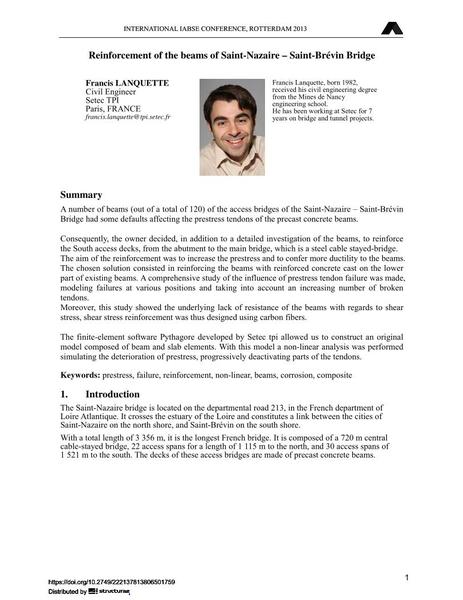Reinforcement of the beams of Saint-Nazaire – Saint-Brévin Bridge

|
|
|||||||||||
Détails bibliographiques
| Auteur(s): |
Francis Lanquette
|
||||
|---|---|---|---|---|---|
| Médium: | papier de conférence | ||||
| Langue(s): | anglais | ||||
| Conférence: | IABSE Conference: Assessment, Upgrading and Refurbishment of Infrastructures, Rotterdam, The Netherlands, 6-8 May 2013 | ||||
| Publié dans: | IABSE Conference, Rotterdam, May 2013 | ||||
|
|||||
| Page(s): | 384-385 | ||||
| Nombre total de pages (du PDF): | 8 | ||||
| Année: | 2013 | ||||
| DOI: | 10.2749/222137813806501759 | ||||
| Abstrait: |
A number of beams (out of a total of 120) of the access bridges of the Saint-Nazaire – Saint-Brévin Bridge had some defaults affecting the prestress tendons of the precast concrete beams. Consequently, the owner decided, in addition to a detailed investigation of the beams, to reinforce the South access decks, from the abutment to the main bridge, which is a steel cable stayed-bridge. The aim of the reinforcement was to increase the prestress and to confer more ductility to the beams. The chosen solution consisted in reinforcing the beams with reinforced concrete cast on the lower part of existing beams. A comprehensive study of the influence of prestress tendon failure was made, modeling failures at various positions and taking into account an increasing number of broken tendons. Moreover, this study showed the underlying lack of resistance of the beams with regards to shear stress, shear stress reinforcement was thus designed using carbon fibers. The finite-element software Pythagore developed by Setec tpi allowed us to construct an original model composed of beam and slab elements. With this model a non-linear analysis was performed simulating the deterioration of prestress, progressively deactivating parts of the tendons. |
||||
| Mots-clé: |
ferraillage poutres
|
||||
